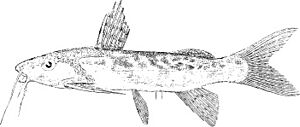Synodontis nebulosus facts for kids
Quick facts for kids Synodontis nebulosus |
|
|---|---|
 |
|
| Conservation status | |
| Scientific classification | |
| Genus: |
Synodontis
|
| Species: |
nebulosus
|
The Synodontis nebulosus is a cool fish often called the cloudy squeaker or clouded squeaker. It's a type of upside-down catfish! This fish lives in the lower Zambezi River area in countries like Malawi, Mozambique, Zambia, and Zimbabwe.
A German naturalist named Wilhelm Peters first described it in 1852. He found it in the Zambezi River near Tete, Mozambique. The name nebulosus comes from a Latin word meaning "cloudy" or "misty."
Contents
About the Cloudy Squeaker's Body
Like all Synodontis fish, the cloudy squeaker has a strong, bony head. This head bone goes all the way back to the first spine of its top fin. Its head also has a special bony bump called a humeral process. This bump helps scientists tell different Synodontis species apart. For the cloudy squeaker, this bump is as wide as it is long and has a pointy back end.
Whiskers and Fins
This fish has three pairs of barbels, which are like whiskers. One pair is on its upper jaw, and two pairs are on its lower jaw. The upper whiskers are long and straight, reaching almost as long as its head. The outer pair of lower whiskers is twice as long as the inner pair. Both pairs of lower whiskers have small branches.
The front edges of the top fin (dorsal fin) and side fins (pectoral fins) are stiff spines. The dorsal fin spine is a bit shorter than the head. It's smooth in front and has small teeth on the back. The rest of the dorsal fin has seven soft rays. The pectoral fin spine is about the same size and has teeth on both sides.
The cloudy squeaker also has a small, fatty fin called an adipose fin. It's five times longer than it is deep. The anal fin, located on its underside, has four unbranched and eight branched rays. Its tail fin is deeply forked, like a "V" shape.
Teeth and Color
All Synodontis fish have a special pad of teeth on the front of their upper jaw. This is called a premaxillary toothpad. It has several rows of short, chisel-shaped teeth. In the cloudy squeaker, this toothpad is short and wide. On its lower jaw, the teeth are hooked and attached to flexible stalks. The cloudy squeaker usually has about 18 teeth on its lower jaw.
The main color of the fish's body is yellowish-green. It has blurry, irregular brown to black spots all over. Its belly is yellowish-white. The fins are also yellowish-green with black spots.
The cloudy squeaker can grow up to about 15 centimeters (about 6 inches) long. Female Synodontis fish are usually a bit bigger than males of the same age.
Where Cloudy Squeakers Live and What They Do
In the wild, you can find the cloudy squeaker in the middle Zambezi River basin. It also lives in the Pungwe River and Buzi River. This fish likes rivers and floodplains, especially floodplains, but it doesn't live in rocky areas.
Reproduction and Diet
We don't know a lot about how most Synodontis species reproduce. However, we do know that spawning (laying eggs) likely happens during the flooding season. This is usually between July and October. During spawning, pairs of fish might swim together.
Synodontis fish are omnivores, meaning they eat both plants and animals. Their diet includes insect larvae, algae, snails, clams, sponges, small crustaceans, and even the eggs of other fish. They grow quickly in their first year, then their growth slows down as they get older.


